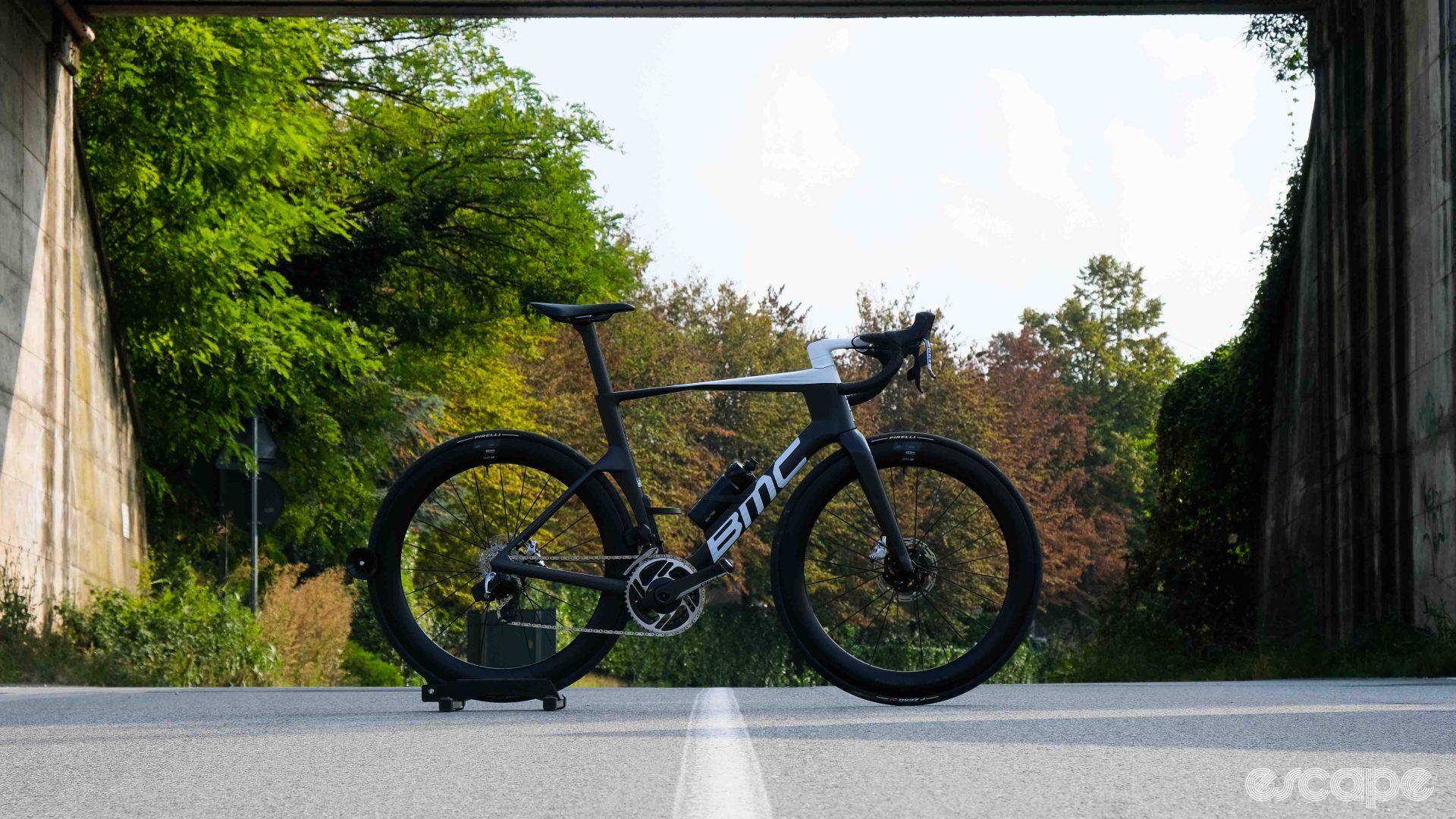BMC has today unveiled its new TeamMachine R, a race bike developed in collaboration with Red Bull Advanced Technologies and said to offer improved aerodynamics and stiffness versus the TimeMachine R it replaces but with a much lower weight and all-around capabilities.
Escape Collective was invited to the launch of the new bike this week. Following two days poring through the details and tech specs of the new bike, countless questions to BMC staff, and two rides through the Lombardy hills on the new bike, here’s what we know so far.
BMC has chosen “Redefine Racing” as the tagline or catchphrase (every launch gets a tagline) for the TeamMachine R. Redefined because, according to BMC, racing is no longer about having a stiff bike or light bike, or even introducing the most aero bike ever created. No, redefined modern racing requires low weight and leading aerodynamics and incredible power transfer.
But staff at BMC were quick to correct me when I referred to the new bike as an “aero bike” – an easy mistake to make, I believe, given its deep-profiled tubes, wide forks, and the fact the new bike replaces the brand’s aero bike while the TeamMachine SLR climbing bike will continue. But, apparently, it is not an aero bike, because, according to BMC, for all their wind-cheating qualities, aero bikes are often characterised by their compromised weight and handling.
Does that mean the TeamMachine is not an aero bike? Well, not quite, in fact it is BMC’s most aerodynamic bike yet. Confused much? Bear with me.
BMC’s objectives for the new TeamMachine were to produce a bike more aerodynamic than the TimeMachine R, increase the torsional and bottom bracket stiffness for improved power transfer compared to the TeamMachine SLR, and do that in a frame weighing within 50 grams of the climbing bike SLR. Or, in other words, the usual lighter, stiffer, and faster than anything that came before it.
Interestingly, though, there was no mention of improved comfort or compliance. This is, after all, a race bike.
Red Bull gives you … wheels
To achieve its goals, BMC turned to Red Bull Advanced Technologies (RBAT), the commercial engineering services and consultancy division of the Red Bull Racing Formula 1 team. While RBAT is born out of an F1 team, it is a commercial business in its own right and for hire. RBAT offers clients the aerodynamic and simulation expertise of an F1 team, and in this case, BMC is a client. Despite the obvious sporting connections and YouTube videos, BMC hires and pays RBAT for its engineering services. It’s partly for that reason there are no RedBull logos on the new bikes.
Red Bull provided the aerodynamic, material, and structural simulation, CFD analysis, wind tunnel validation and crucially the experience and expertise born in F1 with the human resources and the extraordinary computing power required to run such detailed and numerous simulations. In commissioning RBAT, BMC could avail itself of the increased R&D expertise that would otherwise be financially impossible to do in-house. Financially impossible because BMC would have to double or triple its engineer count and computer processing power to name but a couple of examples. That said, there is, of course, the added marketing benefit of hiring the commercial division of an F1 team versus an unknown.
But there are challenges that come with outsourcing the aerodynamic development of a bike to an engineering works with a background in motor racing and presumably little real-world experience of bike racing and UCI rules.
The challenge was is in setting clear objectives and so-called Key Performance Indicators (KPIs) but doing so in a way that allowed RBAT the freedom to bring new ideas and solutions. If the objectives were too narrow, BMC might as well have done it in-house as the results would likely be the same as every BMC that preceded it. But, if the objectives were too wide, then presumably RBAT would come back with a faired recumbent or something way outside the UCI regulations when charged with developing an aerodynamic bike.
Ultimately, BMC decided to fix the geometry of the TeamMachine SLR (with one minor but significant change to seat tube angle), but left every element of the frame’s aerodynamic platform in the hands of RBAT, within the UCI regulations, of course. Perhaps the fact this is the first road bike delivered from the already five-year-old collaboration speaks to how difficult it was to get both partners to sing from the same hymn sheet.
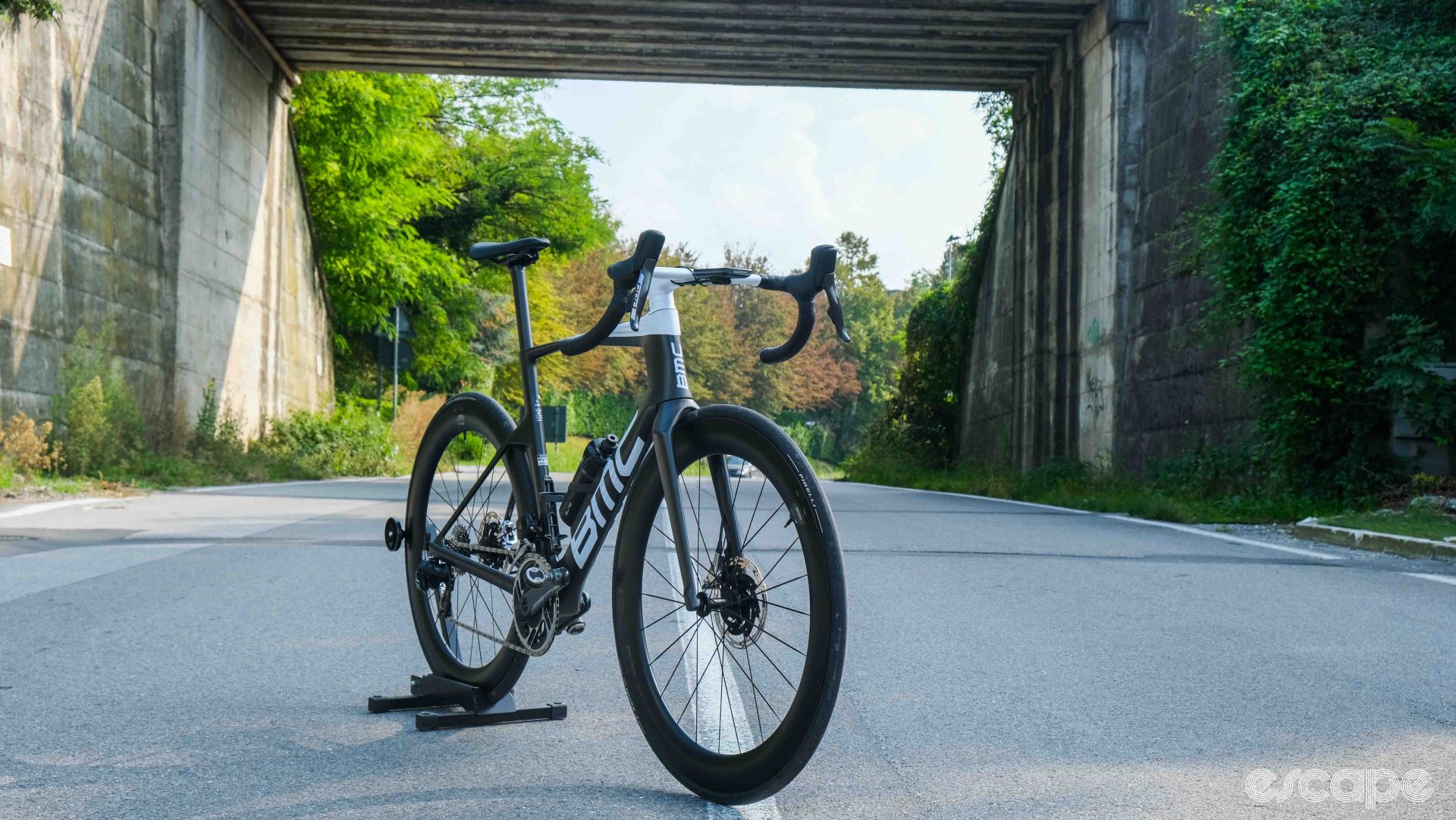
So, does the BMC give you wings?
Probably, but we can get to that in a bit.
The TeamMachine R 01 first appeared at the Critérium du Dauphiné earlier this year, and I think it’s fair to say it was perhaps most intriguing because it was not very BMC at all … and not just because of the Create Speed camo paintjob. There were, of course, elements of BMC’s design language, straight lines, semi-integrated bottle cages, etc., but with wide forks, tapering tubes, and sharp angles, it seemed much more contemporary fashion than the eternal style of the recent TeamMachine bikes and BMC’s design language in general.
As it turns out, unsurprisingly, if you hand over the development of your new bike to an F1 team, you get back something different to anything your in-house bicycle designers created in the past.

The TeamMachine R is very different, BMC say, because it emerged from an entirely new development process. The tapering and kinked top tube, the ultra-wide fork, the narrower and deeper head tube, the truncated tubing, and bottom bracket areas are all “direct results of the computational fluid dynamics (CFD) work done by RBAT.”
Seen now with the commercial colourways, there is a distinct BMC air to the bike, and BMC were happy to admit some aspects of the new frame were included to ensure the new bike carries the brand’s design language in some capacity. That said, it carries more of an air of optimised profiles rather than brand heritage or house design language. As BMC explained, they left the aero platform entirely in Red Bull’s hands, and this is the result.
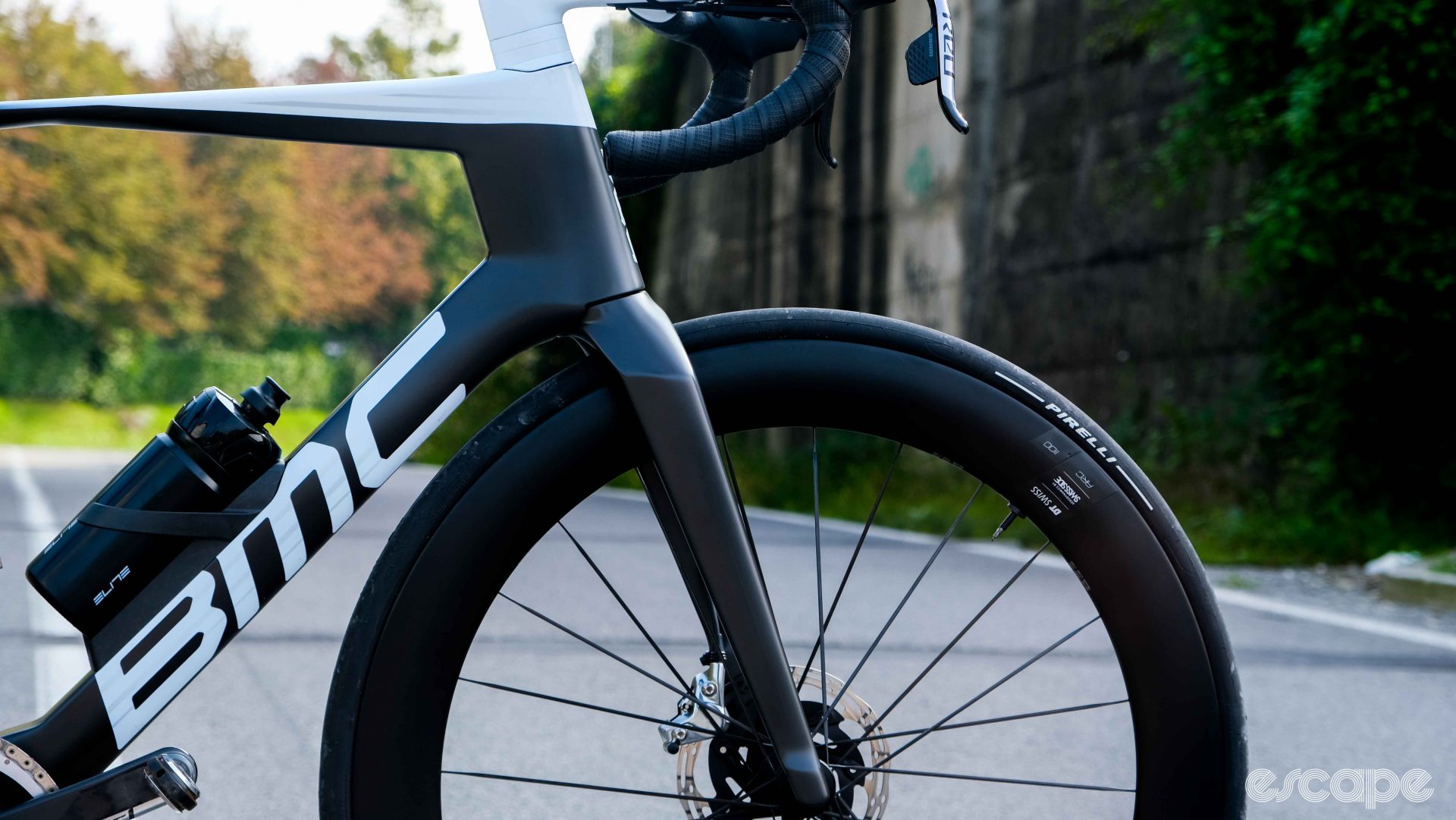
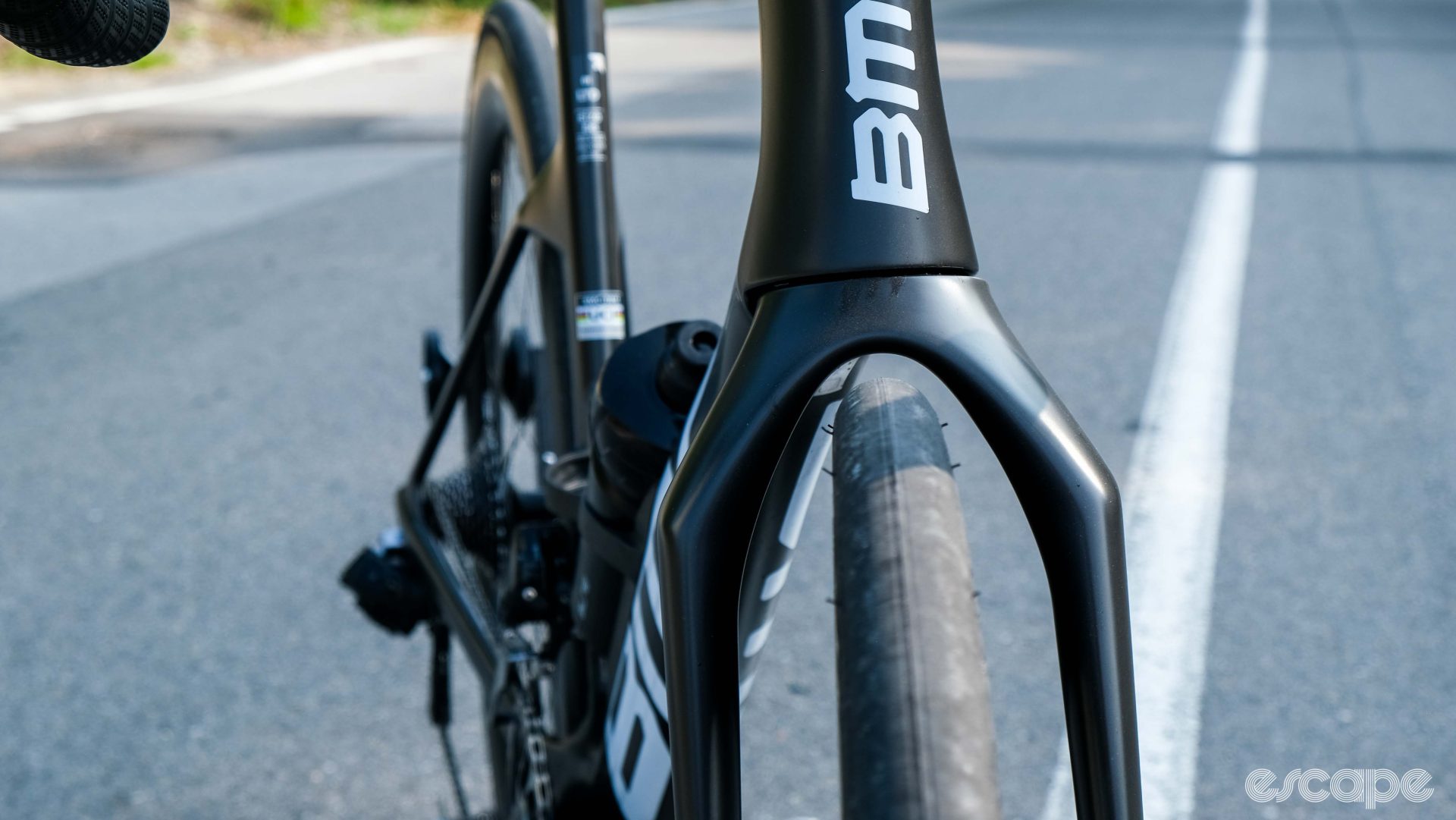
That’s not to say BMC doesn’t own those results. There is, of course, plenty of marketing and feature names included, as is standard with any new bike. There’s the Halo Fork. That wide fork needed a name and Halo provides a nod to the driver-protecting halo in F1 cars and RBAT’s F1 connections. There’s also the Mariana Bottom Bracket, “so deep we named it after the trench.” Cringe, yes, but to be fair, these were delivered with a chuckle during the presentation.
Names aside, these features are based in performance. Take the forks for example. As BMC senior product manager Angelo Lecchi explained to Escape, there are two options when it comes to improving the aerodynamics between wheel and fork interactions: either go extremely narrow which is more aero but comes with other limitations in tyre width and real-world conditions, hence why we usually only see such designs on the track these days. Or go so wide the fork effectively gets out of the way.
The wide-stance fork legs are not some road-going version of the wake-inducing Hope HBT GB track bikes. Instead, they’re said to aid in freeing up space for the turbulent air produced by the rotating front wheel to escape away from the frame and, hence, reduce aero drag in this region while also improving the flow onto the frame. This, again, is said to reduce drag.
Despite all that extra leg stance width, it has to be noted that tyre clearance is limited by today’s standards, especially in a bike that was tested on the cobbles of Roubaix if the presentation videos are to be believed. Officially, the clearance is rated for a maximum 30 mm tyre and optimised around 25-28 mm. In all likelihood, that 30 mm figure probably means the bike will accept a 32, given the ISO requirements for 4 mm of clearance all around.
It seems odd such wide forks would be matched to such a tyre width-restricting crown, but as Lecchi told us, that crown greatly improves front end stiffness and as such was crucial in achieving the overall balance BMC had identified as necessary. More on this later.
Finally, the non-drive-side fork leg features a mound – dare I say fairing? – rising up to meet the front brake calliper and presumably aid the flow over the bulky calliper. BMC has even gone as far as to create its own proprietary calliper adapter size to perfectly match the fork “fairing” to ensure none of these aero gains are lost. That said, one word of warning: this calliper mount is designed for use with 160 mm rotors only, there is no 140 mm rotor option, and other mounts are not compatible.
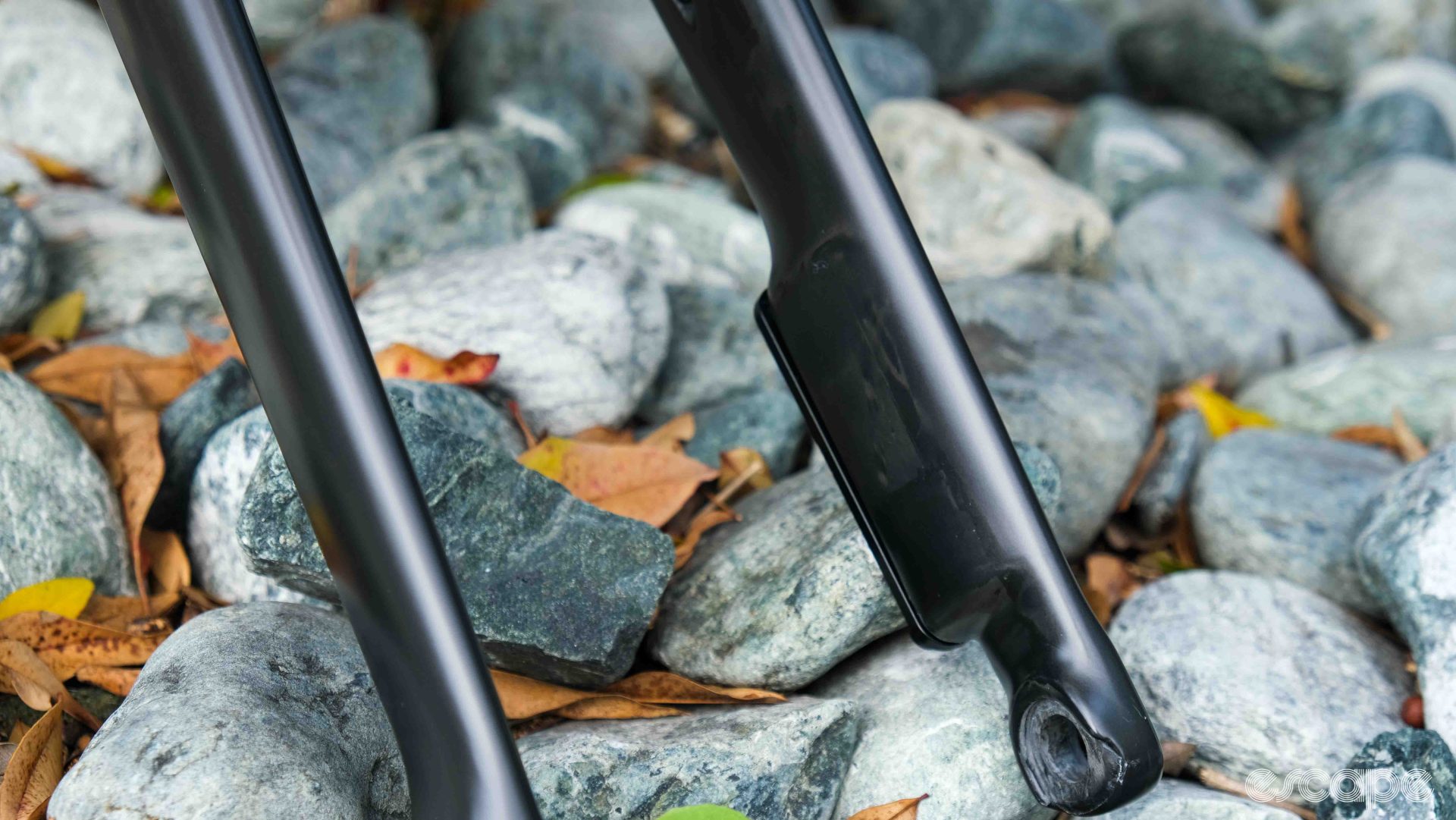
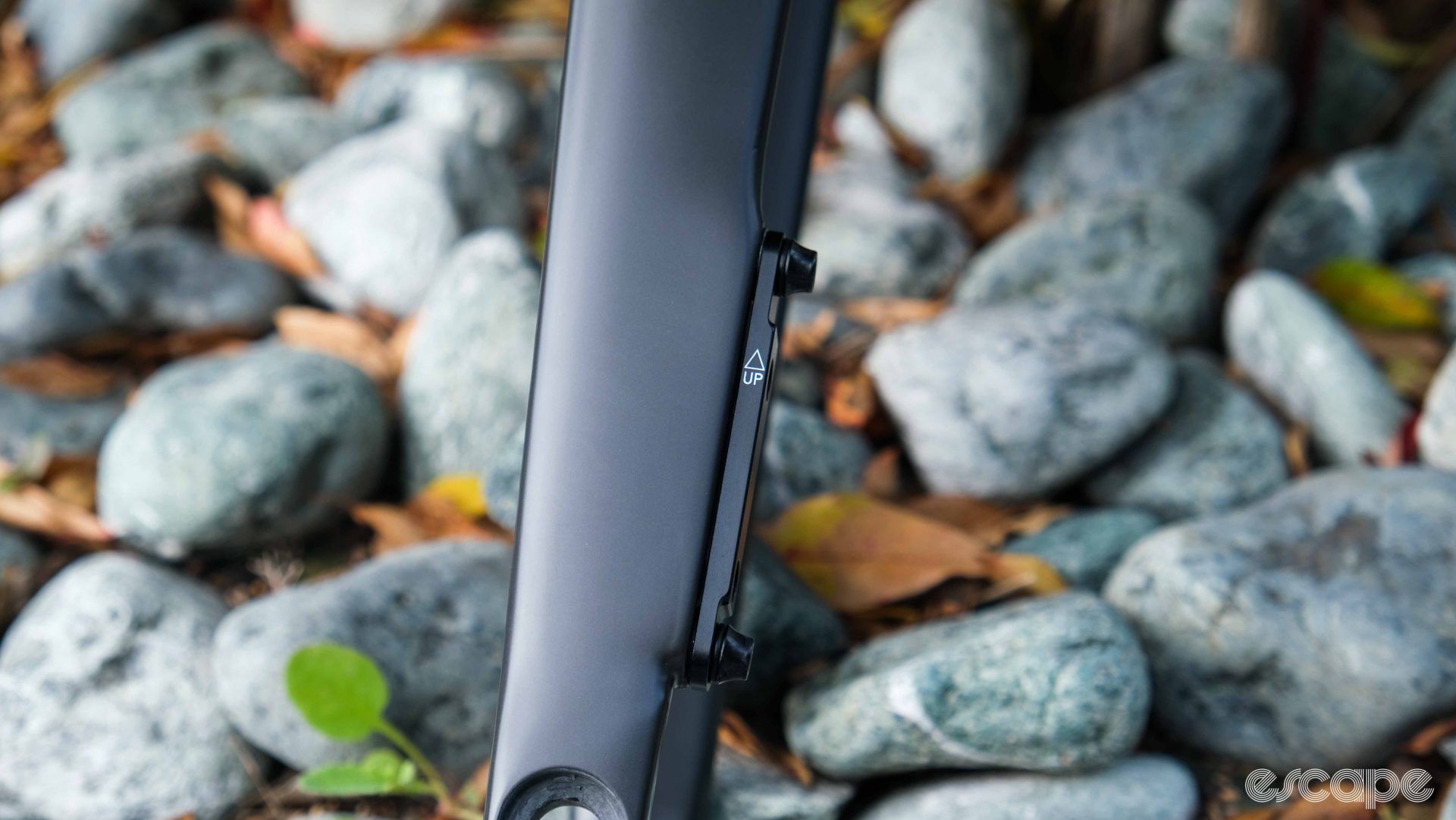

The deeper bottom bracket doubles up to improve flow over the region onto the rear wheel and to improve stiffness. It’s not the tallest bottom bracket we have seen (the new Trek Madone springs to mind as one example of a bottom bracket which may actually be taller) but BMC’s new design does integrate with the down tube as neatly as any I’ve seen with no shoulders or sharp transitions that could presumably introduce more turbulence.
Furthermore, because the increased depth not only mates the bottom bracket, down tube, and seat tube, but also extends to connect chainstays to the bottom bracket and seat tube, the overall surface area is even larger and, according to BMC, this further aids flow transition on the rear rim, reducing tyre flow separation in this area. The fact the section forward of the seat tube perfectly lines up with the section rear of the seat tube is one area BMC was able to add in some of its design language without disrupting the careful aero characteristics RBAT had delivered, apparently.
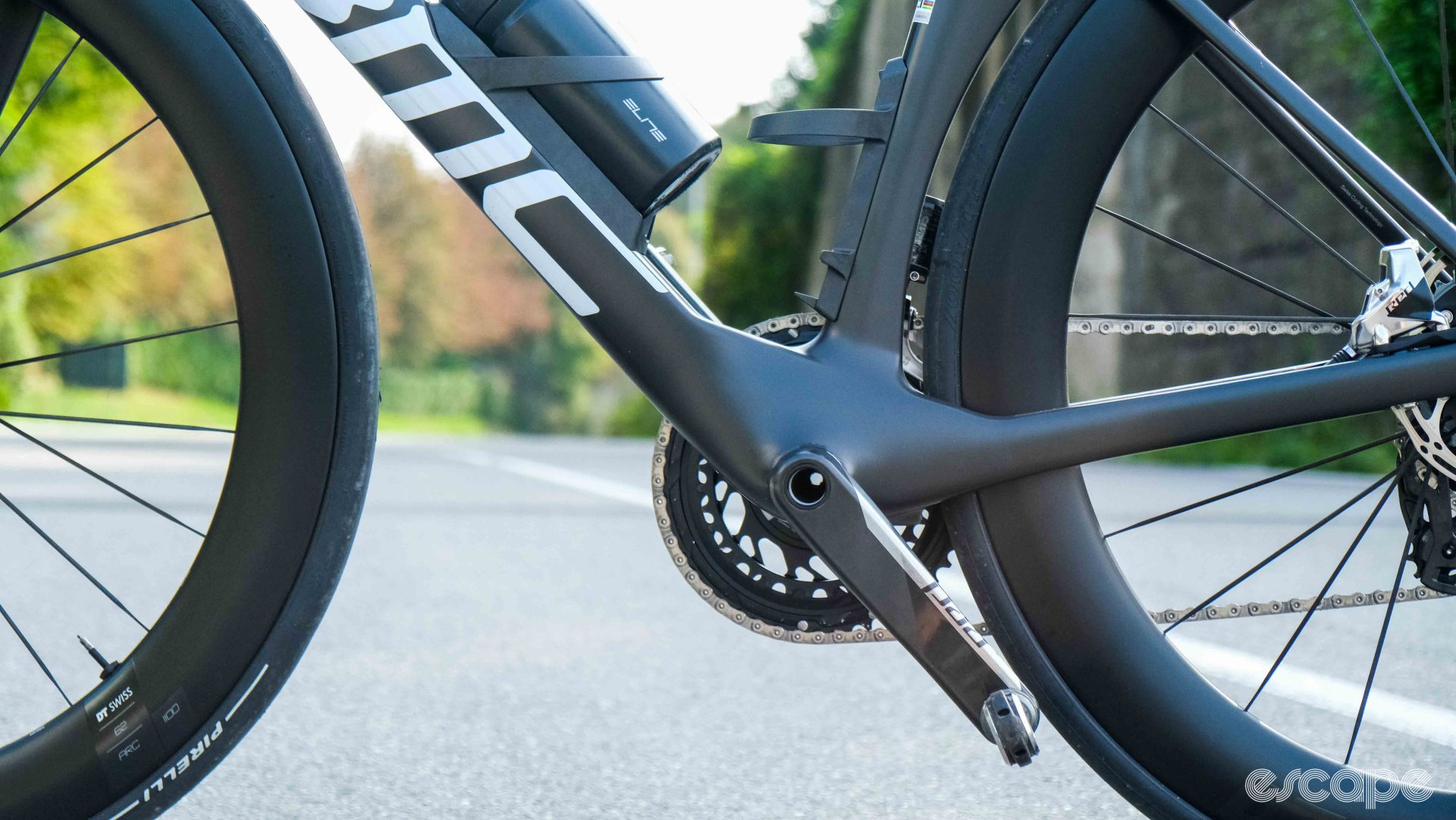
Perhaps nowhere was BMC’s willingness to hand the reins to RBAT and sacrifice house design language more obvious than on the head tube and frontal profile. When I think BMC, especially TeamMachine, my mind thinks chunky, almost bulbous or squared-off head tubes. Compare that to the streamlined head tube and frontal profile of the new TeamMachine R, and the RBAT influence becomes evident.
Unsurprisingly, reducing the frontal area of key sections of the frame was identified as a significant aerodynamic opportunity. BMC explained the use of unique weave patterns and layup protocols ensured the width reduction didn’t create a knock-on loss in stiffness or compliance.
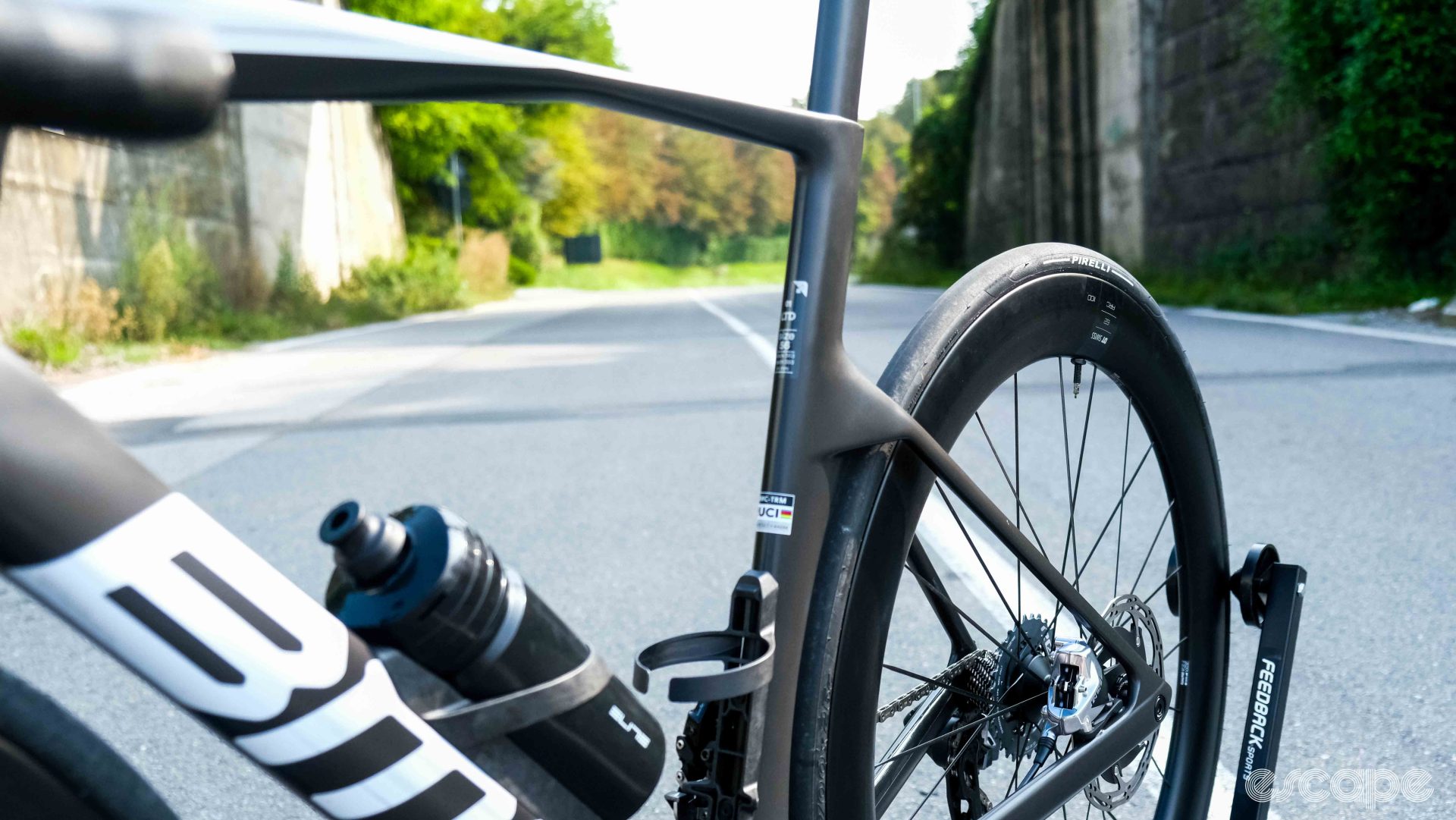
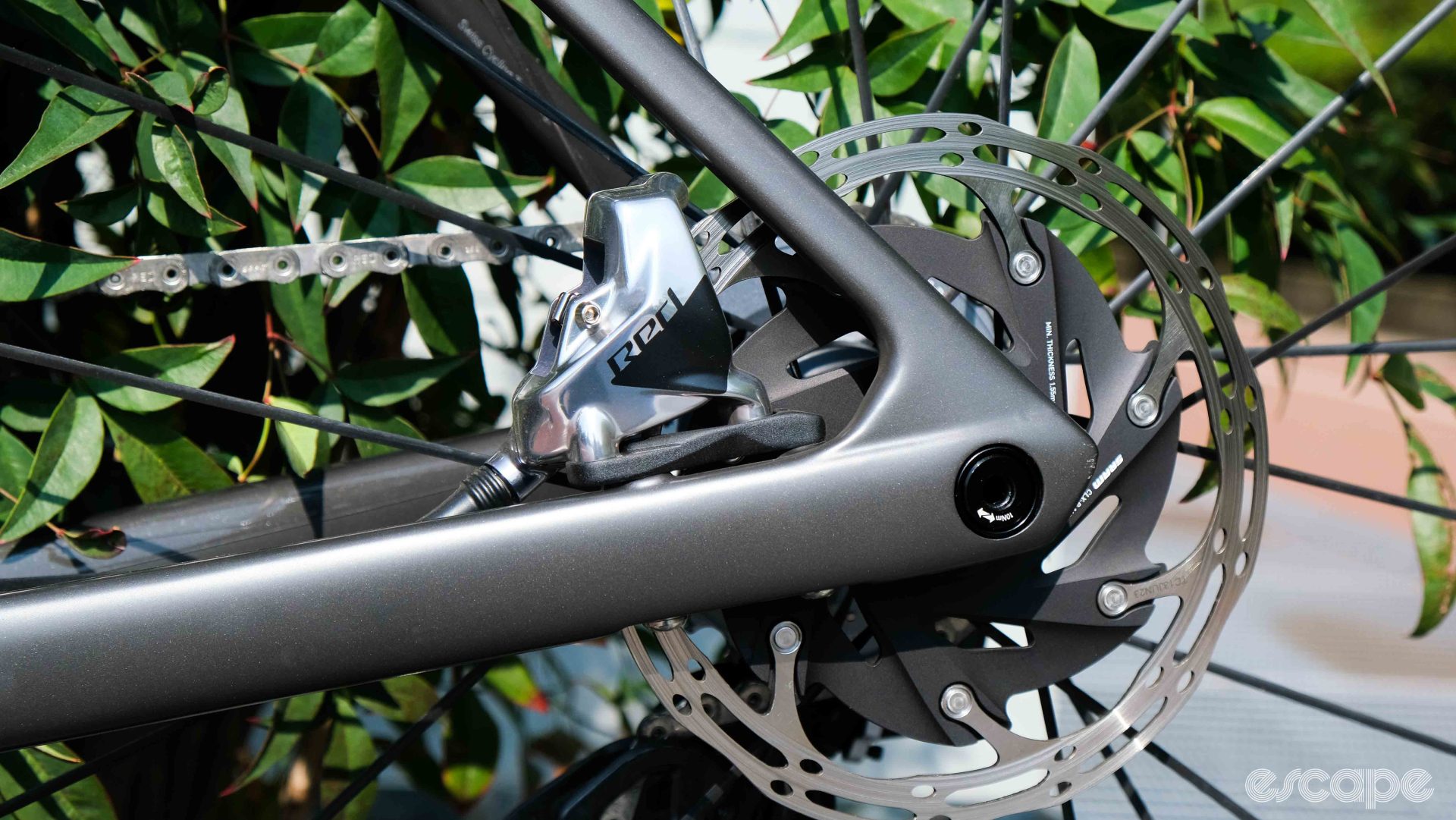
Doubling up
Certain elements are carry-overs from the existing bikes. The Aerocore integrated bottle cages are immediately obvious, but there are others also. The ICS Aero Cockpit is very similar in setup to that of the ICS Carbon Cockpit on the SLR, with the same rectangular fork steerer, the headset, and the brake hose routing, all of which mean fully internal routing rather than the lesser of two evils, externally hidden routing most mechanics would prefer to see.
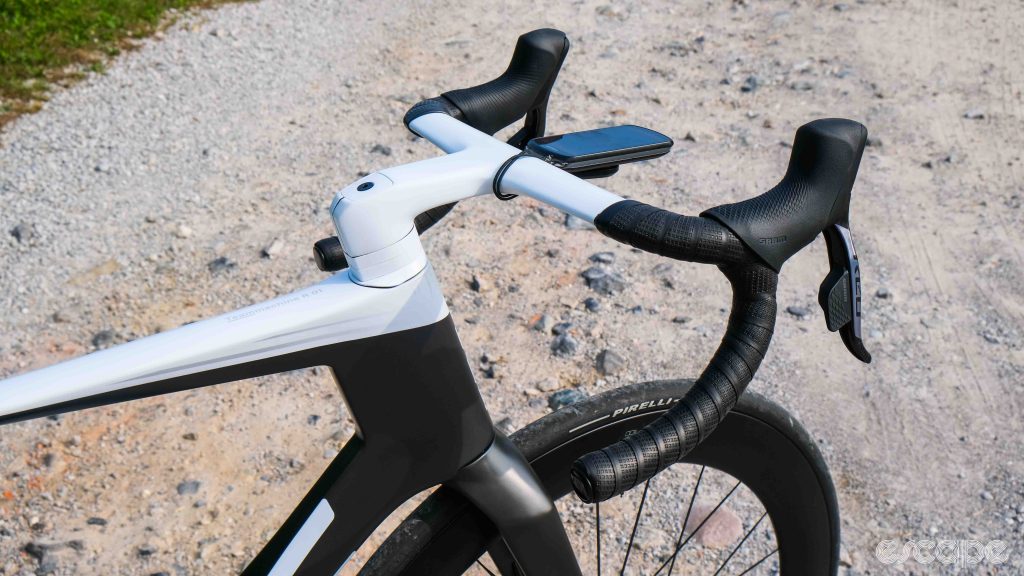
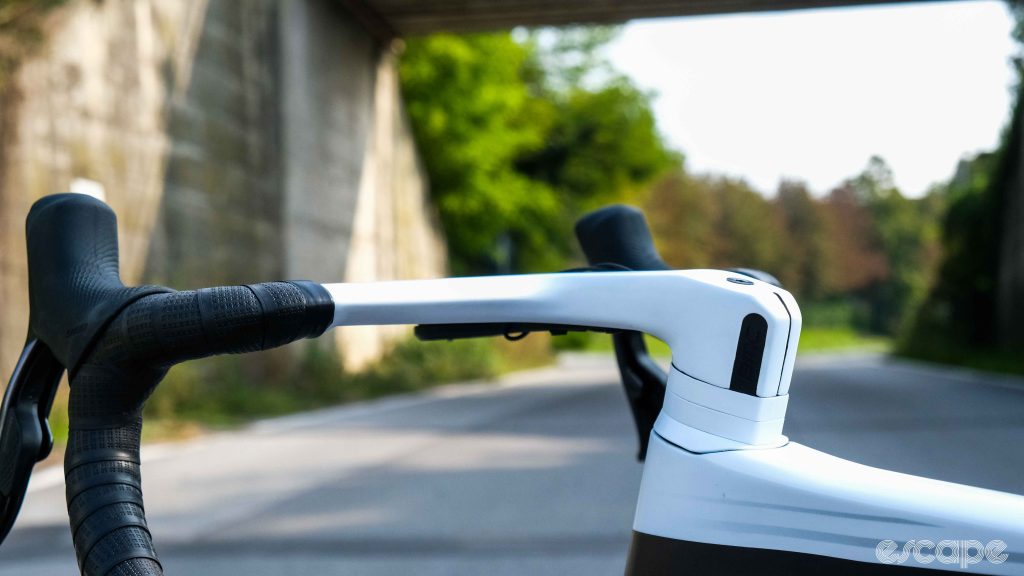

While the bars are similar to those on the SLR, they are much more aero-profiled around the stem interface and, interestingly, are only available in one width – 36 cm at the hoods and 42 cm at the drops. The inclusion of such narrow bars at the hoods is perhaps unsurprising on an aero bike, and BMC claims it received no complaints from the pro riders already using the same bars on the Timemachine road. In better news, the integrated stem is available in every length from 80 mm all the way up to 140 mm in 10 mm increments. Although stock bikes each get a stock stem length, BMC says dealers will help customers ensure bikes are delivered with the preferred stem length during the ordering process.
BMC made no reference to RBAT’s involvement in the new handlebar design, perhaps a little surprising given how key this area can be in overall aerodynamics. The tops are far from the most profiled we have seen, in a good way, providing a manageable grip width for most hands. The stem also features a neat taper at the rear, as seen on the SLR’s bars, which perhaps does as much for aesthetics and your knees (no sharp edges to whack when sprinting) as it does for aero.
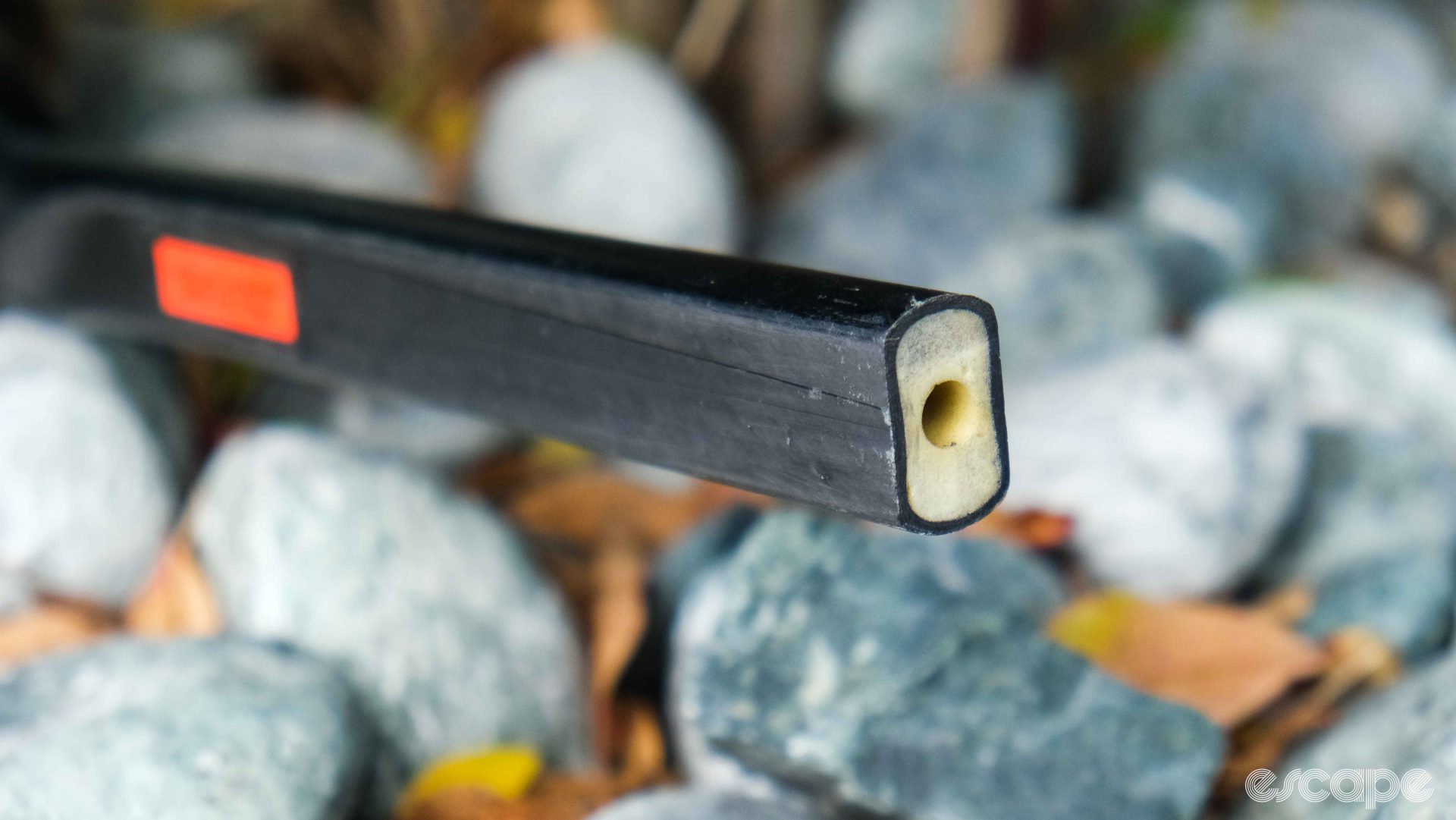

BMC’s “Stealth Dropouts” also make the cut, and were actually off the table for both RBAT and SRAM with its universal derailleur hanger, which, according to BMC, is not required and too aerodynamically costly in a road racing frame compared to the integrated and hidden Stealth Dropouts.
The non-replaceable nature of the Stealth Dropouts did raise a few concerns when BMC first introduced them, but Lecchi told Escape the brand hadn’t received a single warranty claim on the dropouts yet.
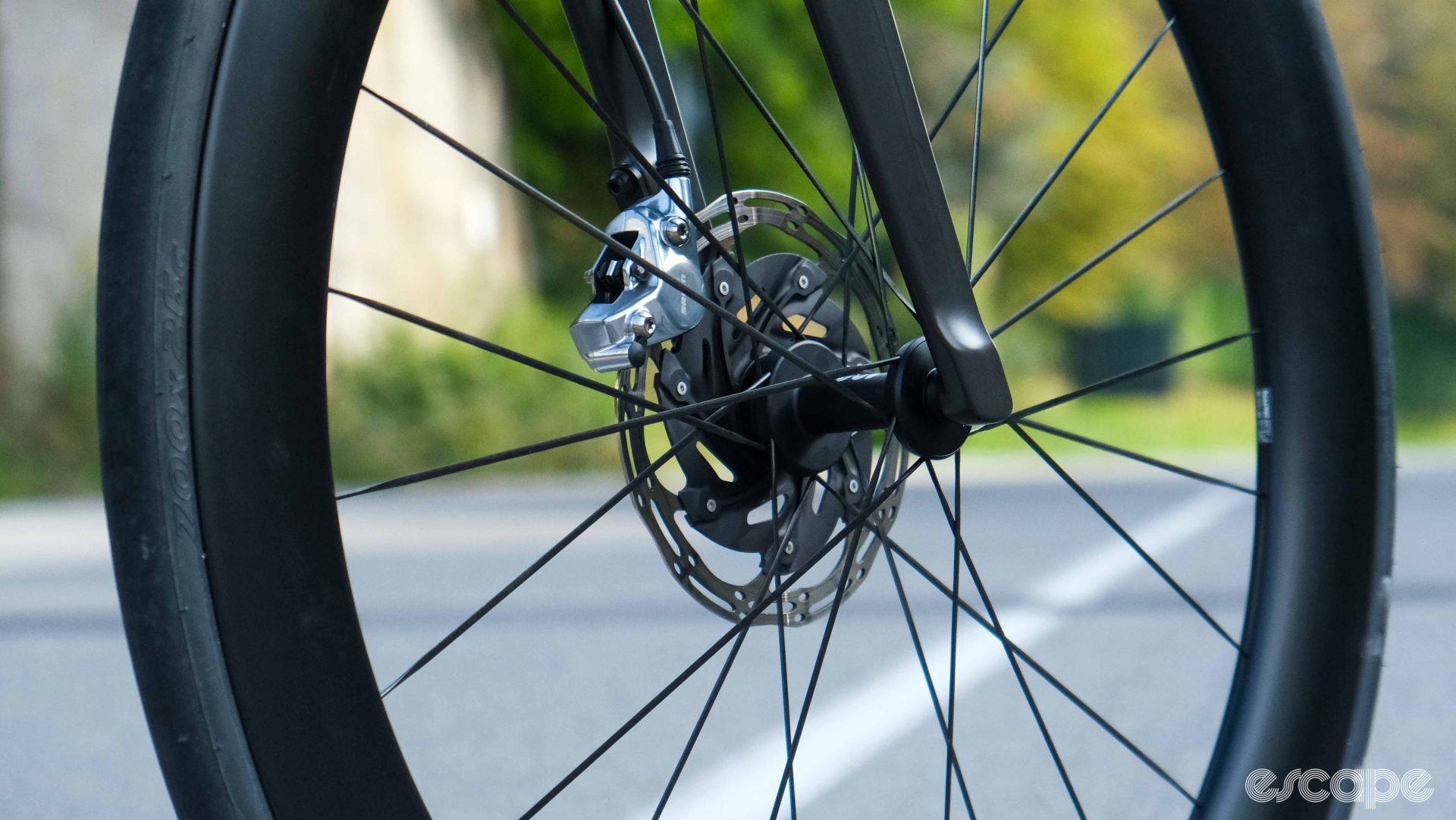
It’s not all aero
But isn’t this “not an aero bike”, and yet all we’ve heard so far is aero? That’s where BMC’s own engineers step in. The Impec Lab team took the aero platform RBAT delivered and turned it into a race bike. Step one was reducing the weight wherever possible to get within that 50-gram target of the SLR.
Immediately I had a two-part question for BMC: 1) how do you make a frame with much deeper and wider tube profiles with the same blend of carbon and yet retain a similar weight to the much more slender climbing frame, and 2) how do you make a bike within 50 g of the SLR when the claimed weight for the TeamMachine R is a pretty average 910 grams? The answer, according to BMC, is in the fine details.
While the head tube, down tube, and bottom bracket all grow in size and hence weight, other areas are greatly reduced in size, either for aero gains and/or weight savings. Take the top tube, for example. The horizontal profile is relatively large where it meets the head tube, but it tapers to almost nothing where it meets the impressively thin seat tube.
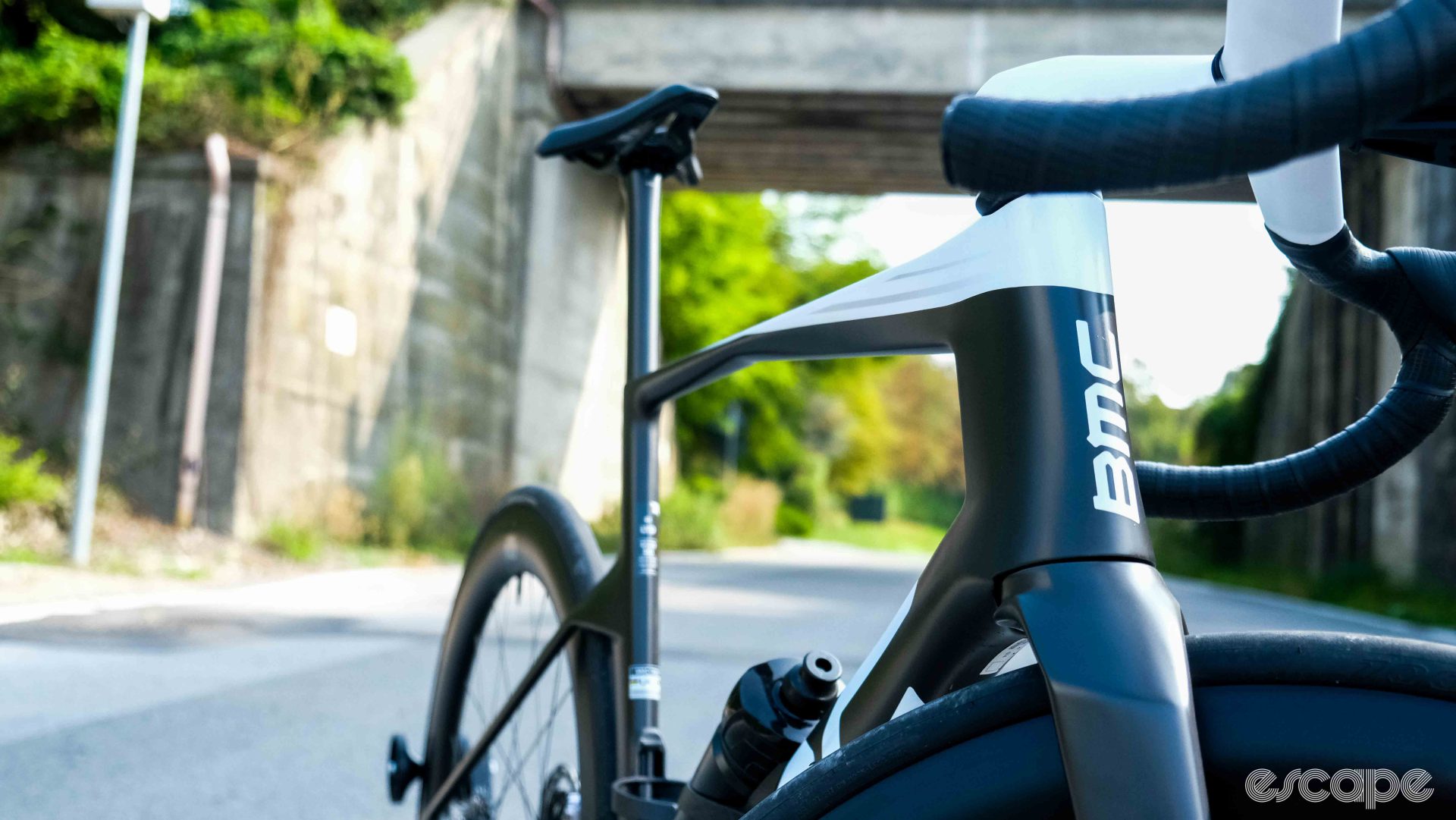
The seatstays are minimal also, while the chainstays are slimmer than those on the SLR. Smaller, thinner, and shallower usually translate to lighter, and BMC has utilised areas where thinner is more aero to reduce drag and weight. Meanwhile, the brand uses smaller profiles in less aero-sensitive areas where deeper profiles don’t provide the same aero advantages.
As for the details, at 155 g, the seat post was created as light and thin as possible while still being wide enough to accept a Di2 battery (a similar Dogma F seat post is around 190 g). BMC has shifted the seatpost clamp from the front of the seat tube on the SLR to the rear on the new bike and now consists of two grub screws and a wedge plate very similar to that of the Pinarello Dogma bikes. The new clamp design and location allow for a slimmer and more aerodynamic seat tube and seat post while also providing some weight savings as the wedge and grub screws combined weigh just 11 g.

But do the slimmer sections make up for all the deeper sections? It seems unlikely, but as BMC explained, there are more ways to reduce weight. Although the carbon is the same 01 grade as used in the SLR 01, BMC found more weight savings in a highly precise layup and manufacturing process.

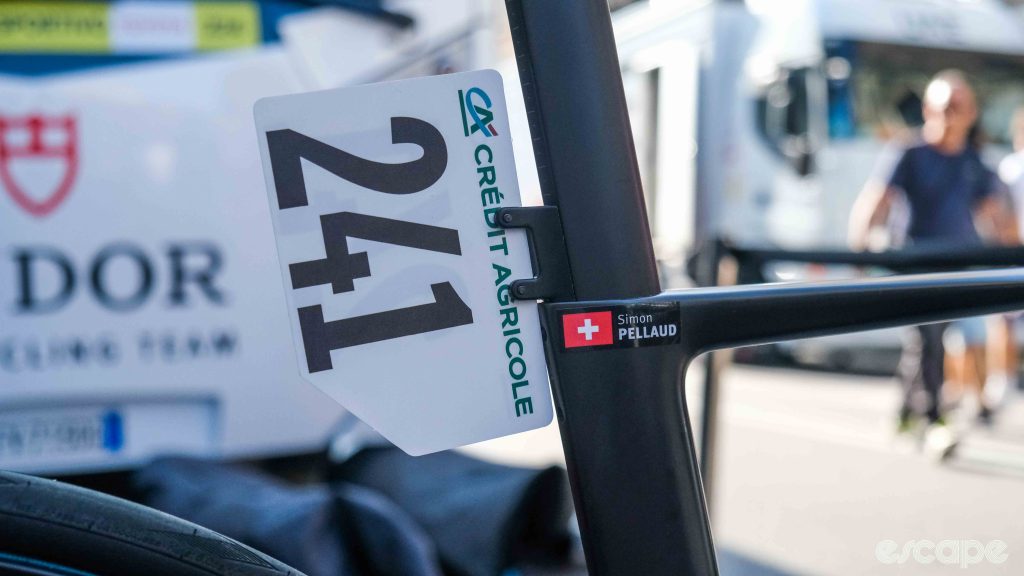
A TeamMachine R frame consists of 350 plies, all cut to millimetre accuracy and placed seemingly even more accurately. It’s a process that takes BMC’s assemblers over four hours per frame and one that sees every tiny excess removed. “The operators have a book to follow for the perfect layup,” BMC explained to Escape. This precise layup is also credited with improving frame stiffness and power transfer, and so presumably an improved stiffness-to-weight ratio.
Still, though, the 950 g frame weight and 7 kg bike (size 54 cm) seemingly don’t add up. BMC says that, firstly, the extra attention to all the finest details makes the difference and, secondly, that figure is a fully prepped frame painted and ready to go – “no tricks” as someone said.
So, does it add up? Well, my size 56 cm equipped with SRAM Red Etap AXS and 62 mm DT Swiss ARC 1100 wheelset, Garmin mount, Quarq crank based power meter, and Wahoo Speedplay Powerlink Zero power pedals (yes, two power meters), with the integrated bottle cages, and the Fizik Argo saddle weighed in at 7.4 kg. Subtract the pedals and go one size smaller and we are likely getting close to that 7 kg target.
Results
According to BMC, the result of all the above is a bike that is 3.5% more aerodynamic than the TeamMachine SLR (the climbing TeamMachine) and 1.9% faster than the TimeMachine R (the outgoing aero bike) tested in the wind tunnel with bike, rider, and equipment at 45 km/h.
Those percentage figures don’t sound like a lot, and BMC were at pains to point out that the bike only ever makes up around 20% of the total drag, so to save 3.5% of the total system drag from only making updates to the much smaller contributing factor is a result BMC is happy with.
That is, of course, the same equation every bike brand encounters, and the last thing we need is another way to communicate aero savings. Asked for clearer details on the aero claims, BMC explained that with everything else equal, that 3.5% saving translates into a 1.5 kph gain for a rider on the new bike at the same watts versus the same rider on the existing SLR at 45 kph.

As the old saying goes, though, power – or speed in this case – is nothing without control. Control in this instance, BMC claims, comes from its tried and tested TeamMachine geometry. The new bike adopts an almost identical geometry to that of BMC’s dedicated climbing bike, with one slight tweak to seat tube angle (STA) to ensure fit parity across the size range, especially for the trend towards more forward saddle positions. While the SLR features a 73.5° STA across the size range, BMC has increased that to 74° for the two smallest 47 and 51 cm frame sizes on the new bike, retained the 73.5° for the middle two 54 and 56 cm sizes, and decreased the angle to 73° for the two largest 58 and 61 cm sizes. The geometry is otherwise identical to that of the SLR save for a mm or two here or there in the stack and reach figures.
That means BMC has also retained almost identical wheelbase, chainstay, and front-centre lengths throughout. The bottom bracket drop and, crucially in my book, trail figures are locked across the size range at 69 and 63 mm.
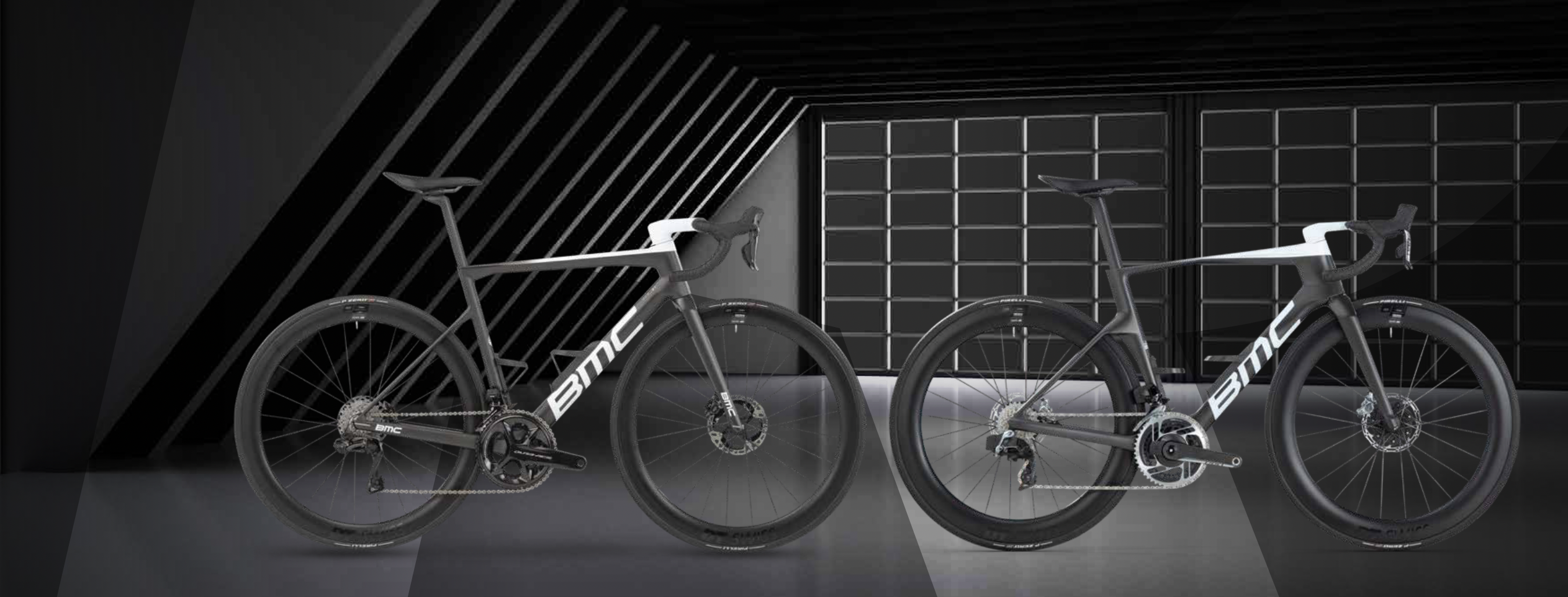
I asked the team at BMC if they could or should have considered a new geometry for the “aero bike” rather than stick with the same geometry from a climbing bike. The brand was clearly very reluctant to deviate from something that has proved popular. “Don’t try to fix something that isn’t broken” kind of thing.
It would, presumably, have been quite easy to grab some headline aero saving by dropping the bottom bracket height and thus the rider for an overall smaller system or to switch to a shorter trail and perhaps chainstays for a snappier, livelier bike. But as Lecchi explains, those moves would have come at the expense of the overall balance BMC wanted to achieve.
That balance, according to Lecchi is achieved in matching the correct stiffness levels front and rear with the geometry to accommodate and inspire the rider. Too aggressive or relaxed on any aspect of the geometry and the bike wouldn’t be as predictable. Lecchi also explained that a bike that is too soft or flexible at the front and stiff at the rear, will feel “loose” at the front and as such, riders would be slower in the corners. The opposite – a stiff front and flexible rear – will leave a sluggish, uninspiring bike.
With that in mind, given the claimed increased stiffness from the Halo Fork, BMC had to increase the bottom bracket and rear triangle stiffness to match. Likewise, while BMC considered tweaking more of the geometry for the new bike, ultimately, that balance it feels the SLR provides was a key aspect to retain in the new bike.
Every geometry choice has pros and cons, though. Personally, I lean towards shorter trail figures than the 63 mm on the TeamMachine R. The Tarmac and Falcn RS I reviewed recently are on the lower end of the modern scale and at 55 mm, provide a livelier, lighter-feeling, and more responsive front end for a bike that feels fast even just riding in a straight line out the driveway. The TeamMachine R doesn’t offer the same initial responsiveness or speed, but what it lacks in that respect, it more than makes up for with high-speed stability and effortless precision cornering.
Those sharper-handling bikes are, I feel, more demanding and require more precision inputs; generally, they work best under the best bike handlers. The TeamMachine R on the other hand seemed to take on much of those demands itself and had me feeling like a descending expert, inspiring confidence from about the second hairpin into our 8 km descent down the Madonna d’Ghisallo that formed the opening section of our first ride on the new bike.
Yes, that’s right, so confident were BMC of this new bike, they took us to the top of a climb and set us off for what was my first-ever ride on a BMC down a treacherous technical descent with sheer drops at the roadside edge all the way down. Their confidence was merited, though, and by the bottom of our third descent of the day, I wondered if there might be a business in renting ski lifts in the summer for downhill road biking.

That gets me to my overall impressions of the new bike. As already mentioned, the bike was amongst the most confidence-inspiring I’ve ridden, especially on tricky technical descents. The TeamMachine R reacts predictably to every command. I was happy to push much further than I typically would on a bike which I am still getting to know.
That said, comfort and compliance were the lowest on BMC’s priority list for the new TeamMachine R, and the same is true for the pros who will ride this bike next season. It is a race bike, so stiffness and a harsh-ish ride are to be expected, and I am absolutely fine with that. With that in mind, I wasn’t in the least bit surprised when the TeamMachine R made a point of informing me, rather abruptly, of every rut, manhole cover, and pothole along the route like some pesky sat nav.
That said, just as a sat-nav shuts up between turns, I continually found myself surprised by just how smooth, relatively speaking, the ride was on most other surfaces, even those less-than-perfect rural roads. Of course, tyre pressure is crucial in this regard. I found the BMC was surprisingly accommodating in the mid to high 60s psi (4.4-4.8 bar). I did try mid-70s psi (5.1 bar) for my third ride on the TeamMachine, and the difference was notable with a gentle road buzz on all but the smoothest surfaces.
That said, despite all it’s stiffness, the TeamMachine never felt jittery on the front, even descending on rough surfaces, and I’d no bother keeping the rear wheel planted while sprinting out of the saddle.
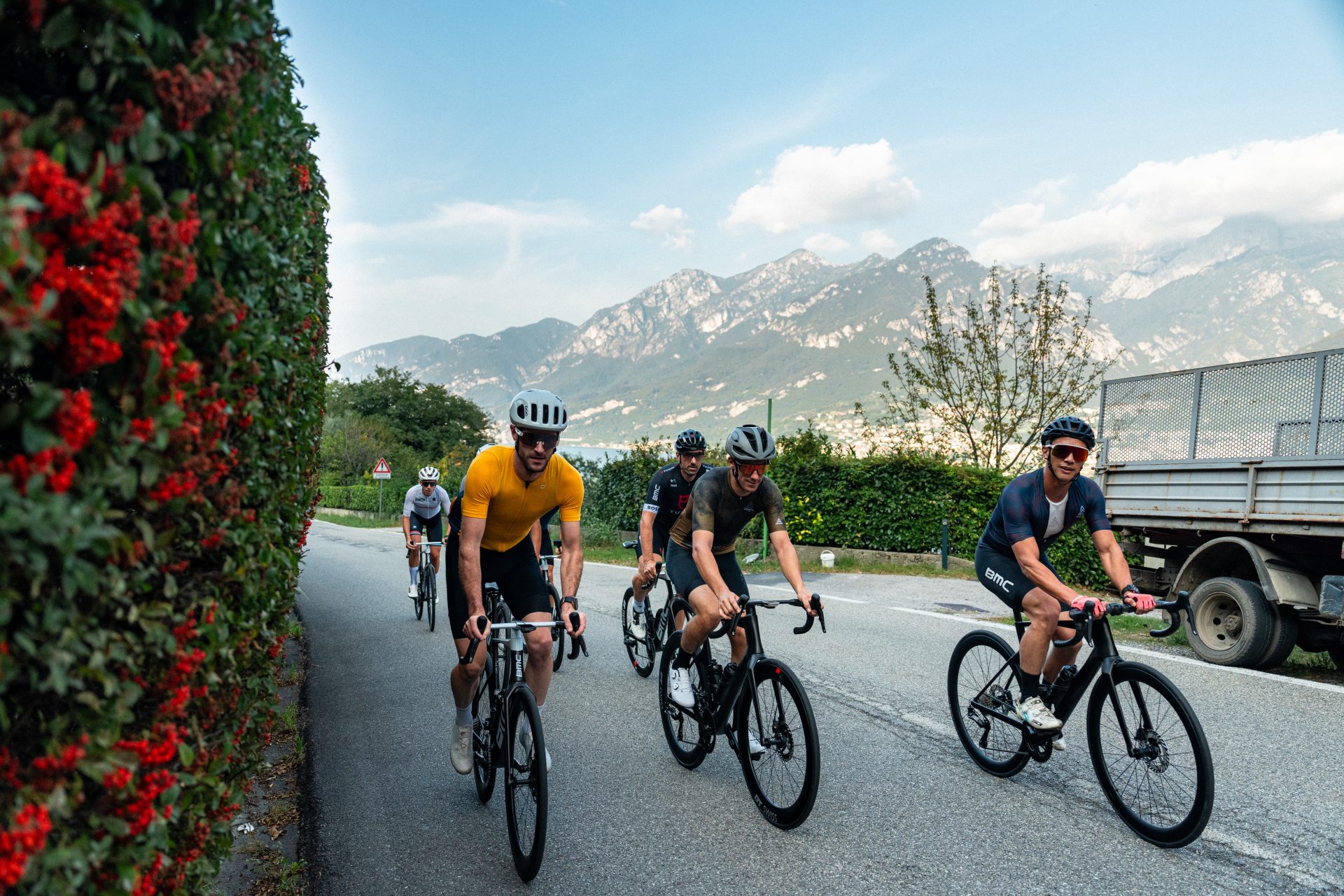
What, then, about performance, did the presumably expensive Red Bull Advanced Technology engineers deliver? Well, it’s impossible to tell if I might have been riding 45 km/h when actually I was riding 46.5 km/h had it not been for their involvement, and I didn’t get an opportunity to aero test the two TeamMachines back-to-back. But what I can say is I’d want to race this bike. In fact, the bike would even have me reconsidering the notion I’d had enough road racing to do me for at least the foreseeable future.
The bike, as mentioned previously, is stiff, and that stiffness provides excellent power transfer, which in turn had me feeling like a bike racer when accelerating or attacking. Three or four times, I found myself in a nice position to launch an attack or mimic a sprint when rolling into a gentle gradient from a false flat downhill or just as the group was decelerating and a gap opened to accelerate out of, especially during a little showboating near the end of the ride. Each and every time the TeamMachine absorbed whatever power and force I had and converted it into forward momentum so well, I found myself maintaining the attack for two or three times as long as I would otherwise have done. Think going for a short town sign sprint and instead doing a 30-60-second sustained attack. Smile! On! Face!
I was a little less sure about the ICS Carbon Aero handlebars. They initially didn’t feel overly harsh or notably stiff, but I found zero discernable flex, regardless of how hard I sprinted. The same is true of the front end. This is of course a good thing in a race bike. That said, combined with the lever-altering drop flare – something I don’t particularly like – I was finding some hot spots and general discomfort by the end of a 90 km ride on the fourth day of the trip. A pair of padded (aero) race mitts would probably help no end, and I am reluctant to fault the bar for being as stiff as racers will demand, but it is there and, hence, worth noting.
Finally, the bar tops do feel a little slippy even in dry conditions. I’d be a little concerned they could pose a grip issue in the wet.
The front and rear balance was evident even before Lecchi mentioned it. The rear of the frame transfers power efficiently to the rear wheel again without any sense of flex yet also keeps the rear wheel firmly planted without power-robbing skips or hops across the ground.
Usually, I sprint like a boiled noodle, and this is only exacerbated by any flex in the frame. Noodle frames and noodle arms do not make a pretty sprinting sight, and they feel equally bad. But I felt the TeamMachine flattered whatever sprinting ability I have, and the stiffness kept my flailing body in rhythm. The same was true for slower-speed climbing out of the saddle. Even dropping my body weight and some watts through the pedals to maintain forward momentum on steep climbs offered zero signs of flex.
Speaking of climbing, the TeamMachine R doesn’t, unsurprisingly, feel like the most nimble of bikes and there’s no sensation of dancing on the climbs. But there is a certain relentlessness to it. There’s no immediate sense of sheer acceleration when jumping out of the saddle and powering on the pedals, but there is always a sense that all that stiffness is converting every watt into forward momentum. It’s ruthlessly effective and seemingly unapologetically in showing zero regard for any flare or panache that doesn’t equate into speed.
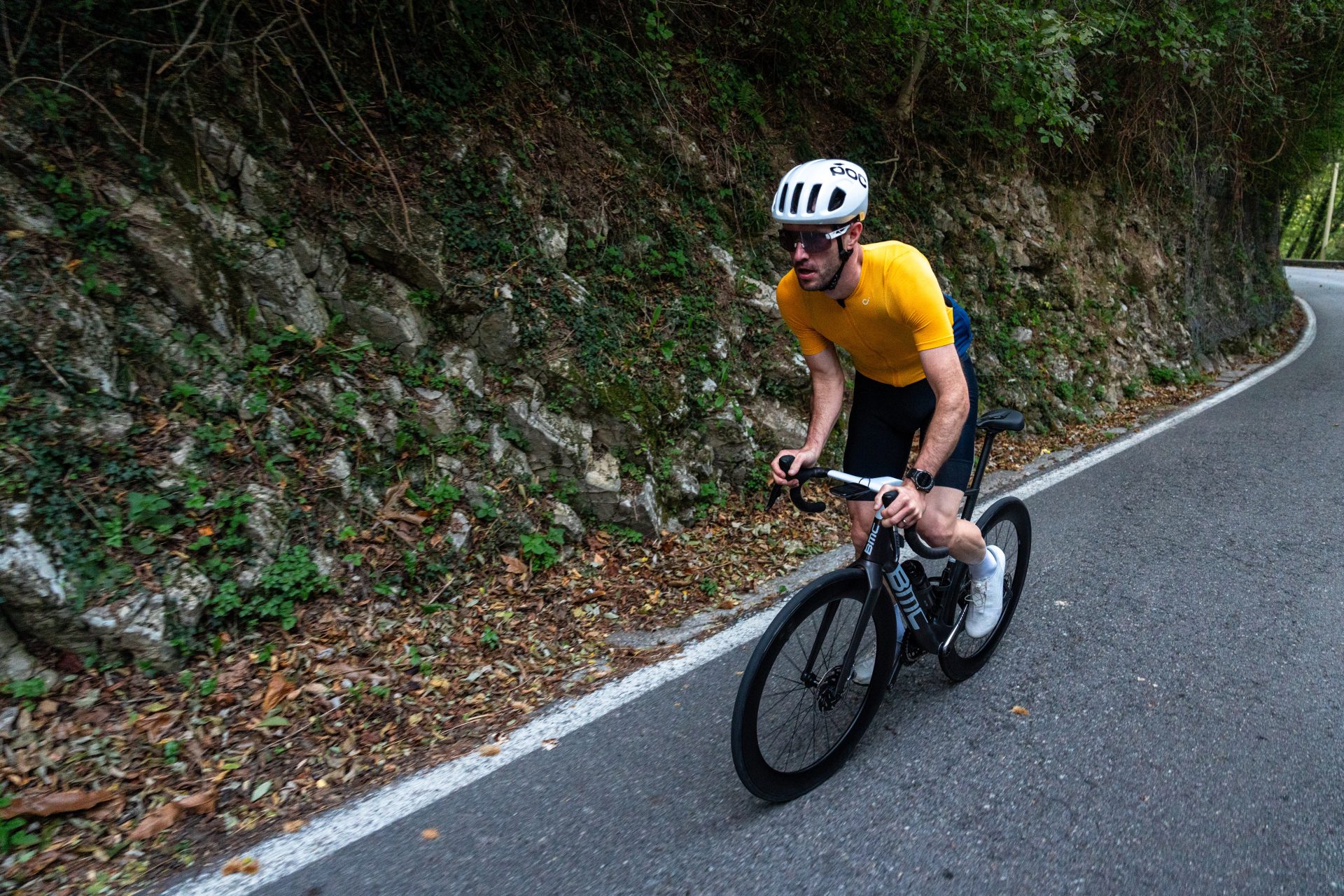
As for speed, the TeamMachine R is fast. Better yet it seems to have a knack of maintaining that speed better than anything other than a time trial bike. It’s not quite TT bike speed, but it did feel faster than almost any road bike. The lack of input required on any downhill, false flat downhill, or even the significantly reduced requirement when slipstreaming a rider in a group, caught my attention on several occasions. Of course, as we all know, feeling fast and being fast are different things, but in the absence of aero testing, this feeling was all I had.
For all BMC’s mention of balance, balance by its very definition, means an equilibrium between two sides. And for all the good about the TeamMachine, there are a few issues that mean it’s not pure perfection. The bar tops and flare I mentioned earlier didn’t exact tick my boxes. That said, at least there is an option to run a two-piece setup with any handlebar.
The 30 mm clearance may also prove problematic for some. Tyre widths are still trending up, most other frames in the category have gone much wider, and many (most?) tyre and wheel combos inflate to larger than their stated width. With all that in mind, I do wonder if a frame rated for 30s now might date rather quickly. That said, I do also understand BMC’s explanation that increasing tyre clearance would have come at the expense of more pressing performance issues (like aero and stiffness) for every race bar one in Northern France in early April.
The new seat clamp may be lighter and more aero, but having seen similar rearward-facing, road-spray-collecting seatpost clamp grub screw setups on Pinarellos over the past decade corrode, seize, and end up with rounded screw heads, I again wonder if the weight and aero gains from the new clamp spell headache in future. That said, I’ve found a slim bit of electrical tape works wonders for staving off said issues, which have never proved a problem on my Dogma F8.
Perhaps the only truly frustrating decision on BMC’s behalf is to stick with the PF86 bottom bracket standard. Every manufacturer sticking with press fit bottom brackets will tell you they are superior when done well and within the required tolerances. Pretty much every rider, on the other hand, will tell you they’d have preferred to have seen a threaded bottom bracket and at least a T47 setup. Alas, it is what it is now.
Still, though, I’m not convinced there is actually any TeamMachine R equilibrium. The bike’s pros far outweigh the cons in my book and from my limited four-ride experience so far, the car engineers helped deliver the most all-round-impressive double-figure-thousand-price-tag bike I’ve ridden yet.
And that gets me to the final point, which will tip the scales at differing rates for each reader and customer: the price. With a frame costing US$6,000 / €6,000 and complete bikes equipped with SRAM Red AXS topping out at US$15,000 / €15,000, the TeamMachine R is as expensive as it is impressive.
BMC will offer a Shimano Ultegra Di2 option at US$9,200 / €9,000, a Force AXS build at US$9,500 / €9,500, and a Dura-Ace Di2 version at US$14,500 / €14,000.
Each of the top-spec builds are equipped with a power meter, while every build is equipped with suitably deep aero wheels for an aero bike in the DT Swiss ARC 1100 62 mm wheels, Pirelli tyres, and Fizik Argo saddle (which, as a side note, felt superb and blew away any preconceived ideas I had about the shape.)
It’s actually these spec choices that make the TeamMachine’s weight all the more impressive. The DT Swiss ARC wheels are a superb option for trouble free riding, but are verging on the narrow side by modern standards. They are also not the lightest wheels and as such there’s is an obvious weight-saving route here for the frame-only customer. The Argo saddle, as much as I liked it, isn’t challenging the weight weenie leaderboard for saddles either. Clearly there are options for those with the budget and looking to get to 6.8 kg.
There are more expensive and lighter aero or all-rounder bikes available. There are also a lot of bikes available with similar specs for much less cash. But as BMC explained, every element of building a bike, from raw materials in the frame to electricity powering the plants has increased in price in recent years. Those increased costs do also have a knock-on effect, as with every business.
Only BMC knows how much it costs to have Red Bull Advanced Technologies design your aero platform and only the customer can determine if it is worth the outlay. That determination may differ from rider to rider, but somehow, despite not doing anything really revolutionary (we’ve all seen deep and truncated tubes before) it feels like the new BMC is a truly unique take on solving the aero-lightweight balance in a modern racing bike.
Unique in itself does not mean better, but BMC and RBAT have delivered unique in a sensible manner without questionable design choices, questionable features, or unfounded hyperbole. Unlike other aero and all-rounder aero bikes, there is nothing I see as an aero compromise in the R 01. Perhaps the stays could have been a bit more profiled or lower, but even then the junction with the seat tube is as aero-looking as it gets in the road bike space.
BMC’s take on the all-rounder bike is truly an all-rounder. As other brands compromise aerodynamics chasing lower weights, sometimes creating something closer to a heavy climbing bike rather than a light aero bike or some true balance of aero and weight, BMC has not. Like it or not, BMC, you’ve created an aero bike, and you’ve done it in the manner I believe we should be aiming for in 2023: a true aero bike that can challenge the UCI weight limit.
All that’s left to do is to let RBAT loose on a set of true aero handlebars and maybe even wheels. Heck, you could even bring new meaning to a “Red Bull helmet”.
You can learn more about the new BMC TeamMachine R 01 at BMC-Switzerland.com.




Did we do a good job with this story?
